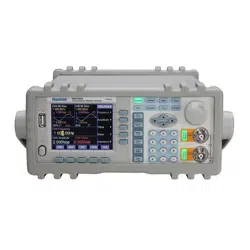Loading ...
Loading ...
Loading ...

the attenuation is fixed and does not change according to amplitude value changes, which make continuous
variation of the output signal in full amplitude range. But in range of 0dB, if the signal amplitude value is too
small, there will be higher waveform distortion and the signal & noise ratio can not be so good.
3.2.5 Output Load
The default amplitude value is calibrated when the output is open circuit. The real voltage on the output load is the
default amplitude multiplying the dividing ratio of the load impedance and the output impedance. The output
impedance of the instrument is about 50Ω. When the load impedance is big enough and the voltage dividing ratio
is close to 1, the loss on the output load impedance can be ignored. The voltage on the load is close to default
amplitude value. When the load impedance is too small, the loss on the output load is significant and can not be
ignored. The voltage on the output load is not same as the default amplitude value. Please pay attention to this
point.
The output of channel A has the over voltage and over current protections. The instrument can not be damaged if
the output is short-circuit for a few minutes or the transient inverse voltage is less than 30V. However, this kind of
operation should avoid in case of potential damage to the instrument.
3.2.6 Amplitude Flatness
If the output frequency is lower than 1MHz, the amplitude and frequency characteristics of the output signal are
very flat. If the output frequency is over 10MHz, due to the characteristics of the output amplitude and load
matching, the amplitude and frequency characteristics of the output signal will not be so good. The maximum
output amplitude is also affected. The higher frequency is, the higher amplitude and the more distortion will be in
output waveform.
3.2.7 Set the Offset of Channel A
Select “Offset” by the corresponding soft key. The current offset value shown on the TFT display changes to
yellow. Input a new offset data here by numeric keypad or rotary dial. Press the key corresponding to the offset
units to confirm the new data input. The function generator outputs the desired signal at the CHA output.
Please note that the sum of half of the signal output amplitude value and the offset value should be less than 10V,
so as to make sure the offset signal peak value is less than ±10V. Otherwise, there will be amplitude distortion.
Besides, when Channel A is at AUTO attenuation, the output offset attenuates as per amplitude attenuation. When
amplitude Vpp value is above about 2V, the actual output offset is the preset offset value. When amplitude Vpp
value is approximately between 0.2V~2V, the actual output offset is 10% of the preset offset value. When the
amplitude Vpp value is approximately less than 0.2V, the actual output offset is 1% of the preset offset value.
When adjusting DC offset value of the signal, the rotary knob is more frequently used than numeric keypad. As a
common rule, tune the rotary knob to the right to increase DC offset level, while to the left to decrease the DC
offset value, regardless of the DC offset value as positive or negative. When the rotary knob tune across zero, the
offset value changes automatically between positive and negative signs.
3.2.8 DC Voltage Output
When the attenuation of channel A is set at 0dB, the output offset is the preset offset value, regardless of
amplitude values. If the amplitude value is set at 0V, the offset value can be set at any value between -10V and
- 13 -
Loading ...
Loading ...
Loading ...
